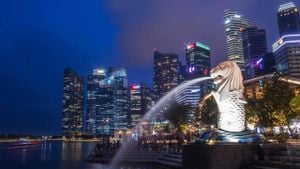Delhi is struggling with severe air pollution, and the situation has escalated dramatically over recent weeks, drawing attention from politicians and health experts alike. The capital has often found itself blanketed by smog, especially as temperatures drop and winter sets in. This year, the crisis has stirred particularly fierce political debates, with leaders from different parties exchanging blame and suggestions for solutions amid rising health concerns about the impacts of poor air quality on citizens.
On November 18, BJP MP Manoj Tiwari distributed N95 masks at the Rajiv Chowk Metro station amid dangerous pollution levels, which had propelled the Air Quality Index (AQI) to alarming heights. He voiced strong criticisms against the Aam Aadmi Party (AAP) government's management of the pollution crisis, asserting it resembled the harsh measures taken during India's Emergency era. Tiwari's actions were part of the BJP’s outreach efforts as the party accused AAP of undue negligence.
Tiwari emphasized the need for immediate and effective measures to tackle pollution, urging citizens to adopt preventive action including wearing masks. Identifying the contribution of vehicles to pollution, he rallied support for BJP-led initiatives purportedly aimed at mitigating the crisis.
Prior to Tiwari’s campaign, Delhi Environment Minister Gopal Rai had also sought urgent intervention from the central government. He described the pollution level as not just concerning but reflective of a medical emergency. The Delhi government repeated its calls for cooperation on measures such as cloud seeding to alleviate smog, though it noted receiving no response to previously sent letters requesting action.
During press briefings, experts and officials shared data showing the extent of the crisis. Dr. Ravindra Khaiwal reported about 900 fire counts from Punjab contributing to Delhi’s pollution woes. He pointed out how prevailing wind patterns were compounding the pollution load, asserting these patterns typically foreshadow worsening conditions across nearby regions.
The public health crisis provoked the Delhi state government to invoke Stage IV of the Graded Response Action Plan (GRAP), affecting schools and public activities. Local districts such as Gautam Buddha Nagar suspended physical classes as AQI ratings surpassed 450, categorizing the air quality as 'severe+' and necessitating contingency measures.
Meanwhile, political tensions surged between the ruling AAP and BJP, with each party accusing the other of failures to implement solutions effectively. BJP leaders criticized the AAP for insufficient public transportation strategies which they claim exacerbated the pollution issue. They highlighted the dire need for systematic changes rather than temporary fixes, questioning whether the existing GRAP stages were genuinely yielding results.
Even as the AAP sought to distance itself from allegations of negligence, it pointed to long-standing systemic issues and stressed its resolve to enforce pollution control measures rigorously. A satisfactory outcome was still uncertain as public sentiment swayed between frustration at governmental inaction and anxiety over the health impacts of the pollution spike.
Citing the need for multidisciplinary strategies to effectively tackle pollution, Aarti Khosla from Climate Trends highlighted how reliance on fossil fuels, inadequate urban planning, and seasonal agricultural burning from areas nearby were part of the comprehensive problems plaguing Delhi. Solutions, she claimed, must address all these factors concurrently.
The AAP government declared it was consulting experts about potential methods to control the smog, including engaging researchers from IIT-Kanpur to discuss artificial rain as one method to cleanse the polluted air. These specialists were expected to convene with the Delhi government, along with numerous stakeholders, to strategize actionable plans to confront smog effectively.
Political maneuvering aside, environmental scientists reiterated the dire nature of the air quality crisis. Alarmingly, conditions have routinely pushed the AQI past dangerous thresholds, and both media reports and scientific studies have raised urgent alarms about the health hazards, including respiratory illnesses and severe long-term consequences for the city’s children.
Observers of the political scene noted how this environmental crisis has allowed for significant discourse on public health, the effectiveness of governmental policies, and the political ramifications of air quality management, unclear as they may be amid the blurring lines between governance and response.
Authorities have also undertaken operational measures to mitigate pollution at public sites, implementing mechanized sweeping and anti-smog campaigns amid rising criticisms of the government's adequacy to enforce pollution-related regulations. This included halting construction projects and increasing monitoring of dust around construction sites.
Delhi's dire air quality issues have frequently garnered attention on larger platforms, including the international discussions at COP29, where experts voiced the necessity for immediate global responses to air pollution, particularly highlighting the risks faced by urban populations such as those residing in Delhi.
While critics continued to voice concerns about the lack of effective stratagem from the leadership, the political battle rages on. Whether Delhi can emerge from this environmental crisis through unified efforts or whether partisan politics will continue to overshadow collaborative resolutions remains to be seen. For residents who must endure this thick fog of unhealthy air, each day remains uncertain and filled with new challenges.
Bringing together the various threads of responses to Delhi's air pollution crisis reveals not just the immediate health risks but also the complex interplay between governance, community action, and environmental science. Without decisive and sustained action, the city's battle with pollution threatens not only the health of its citizens but the very future of its urban environment.



